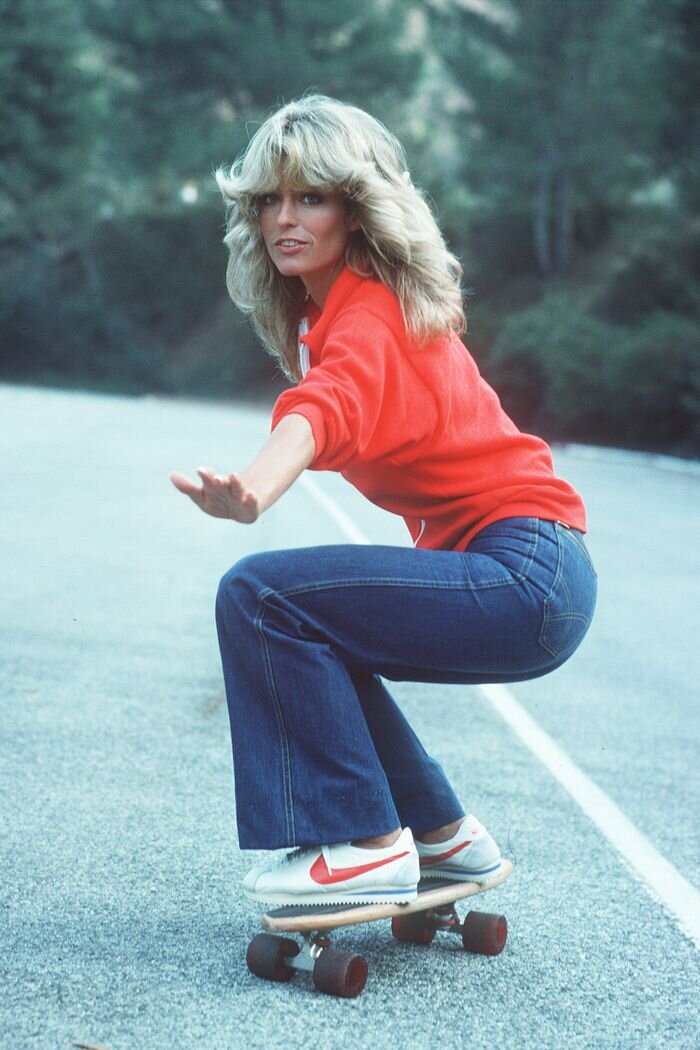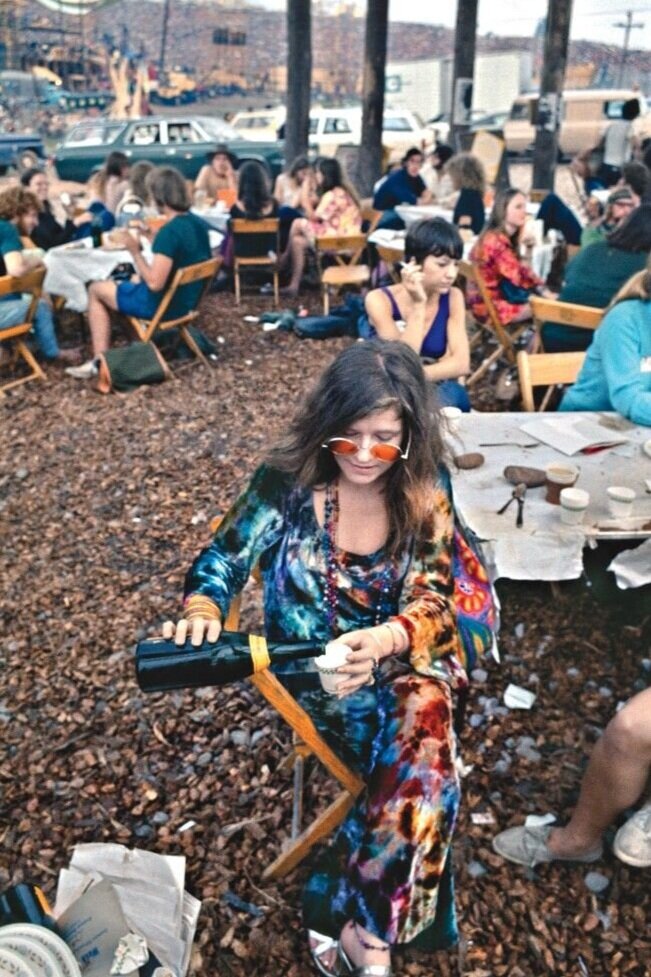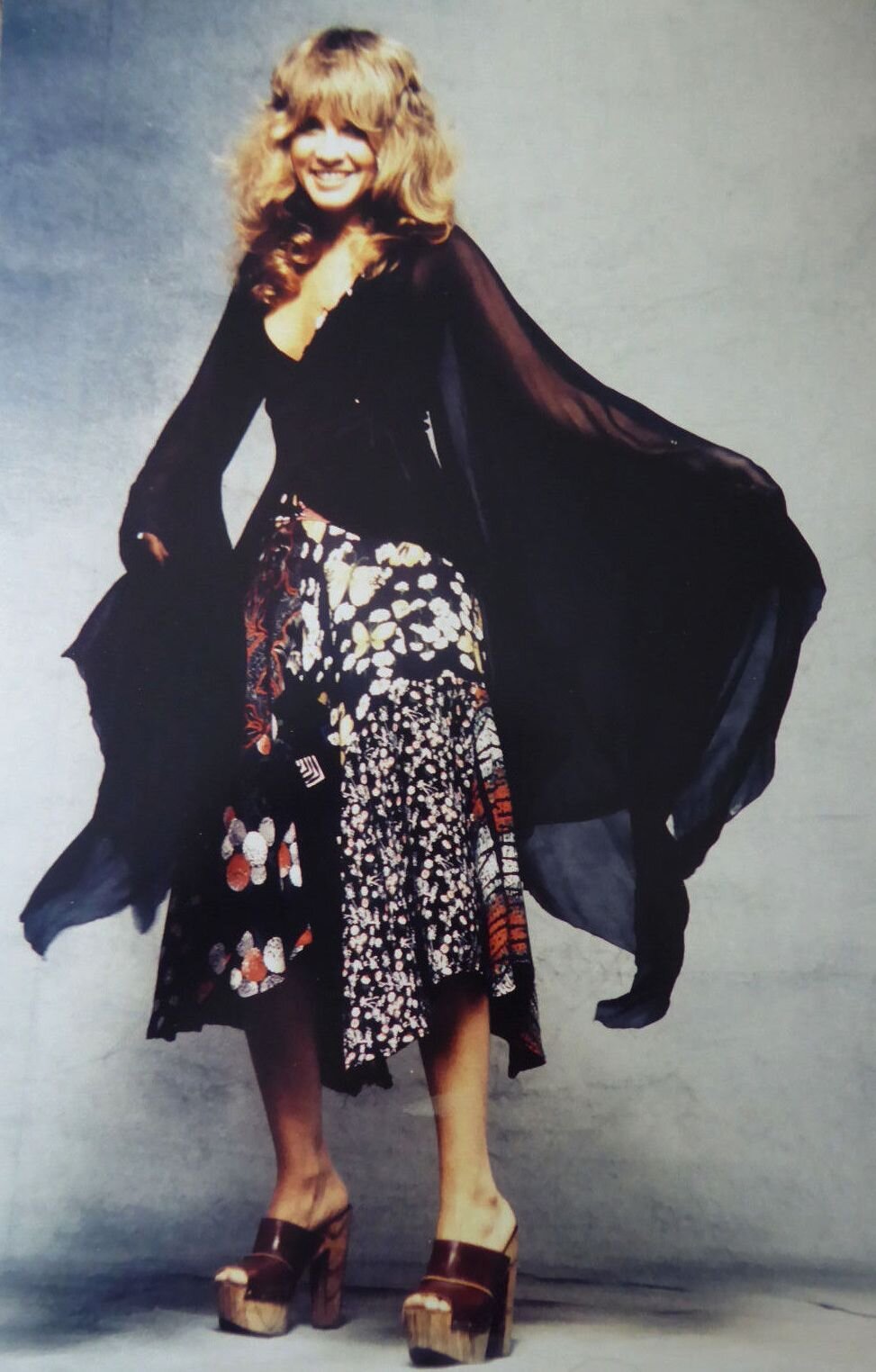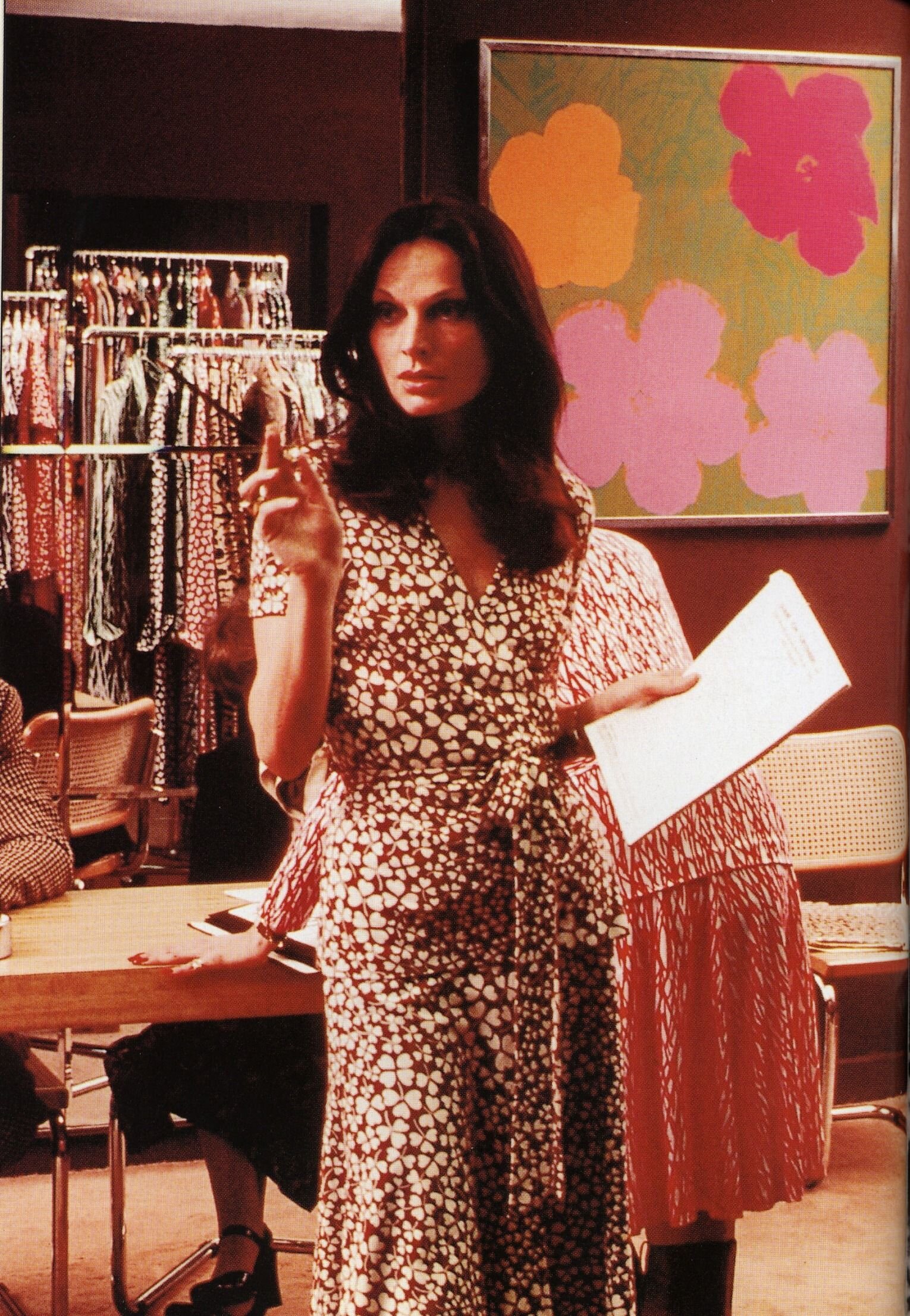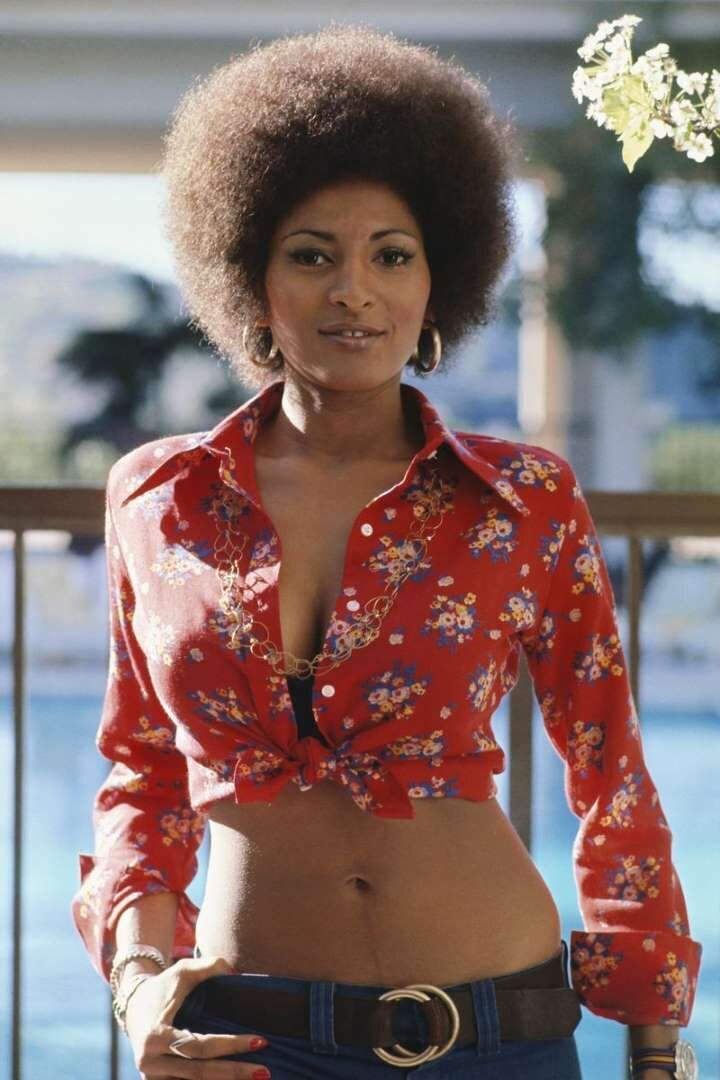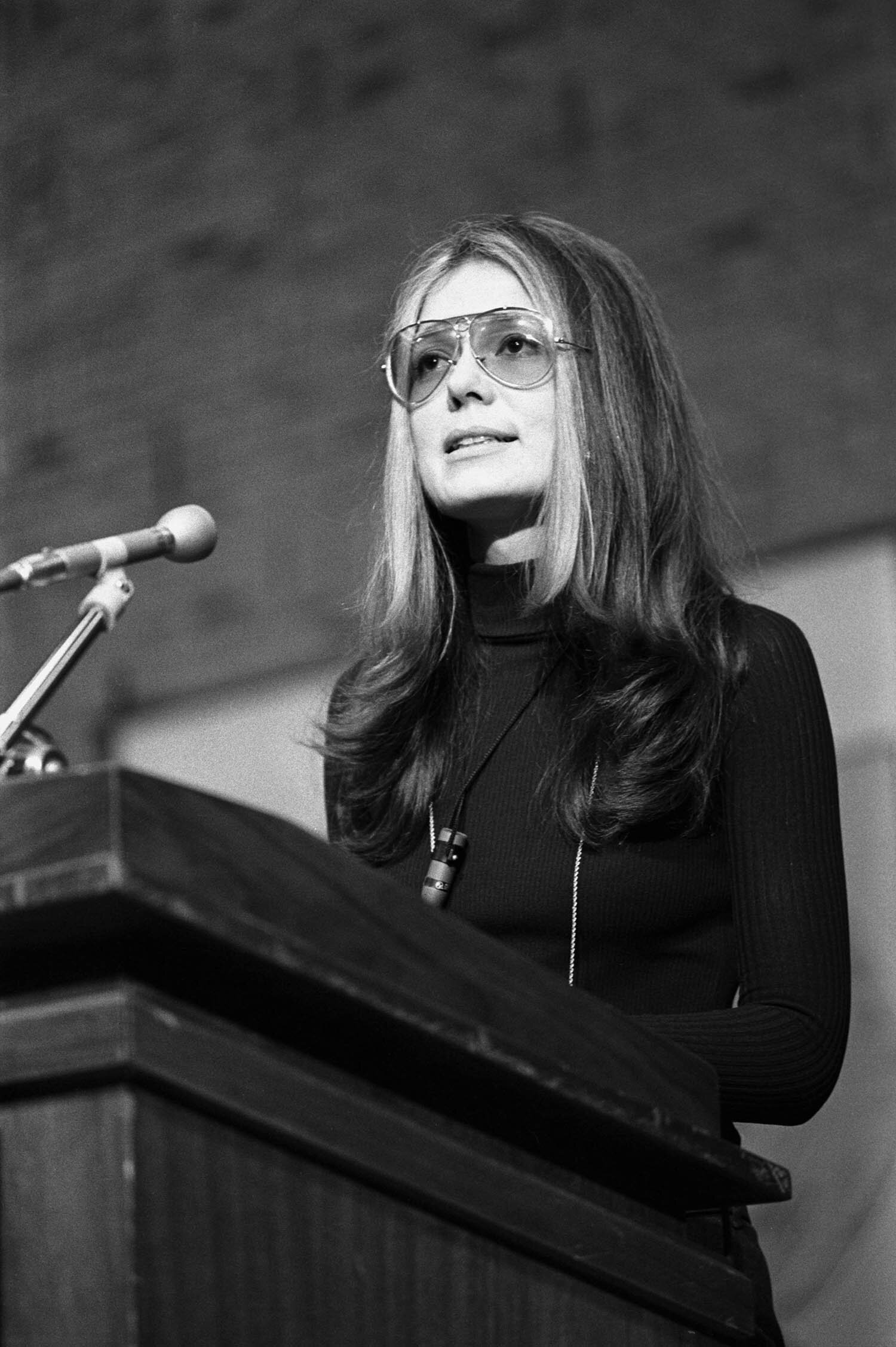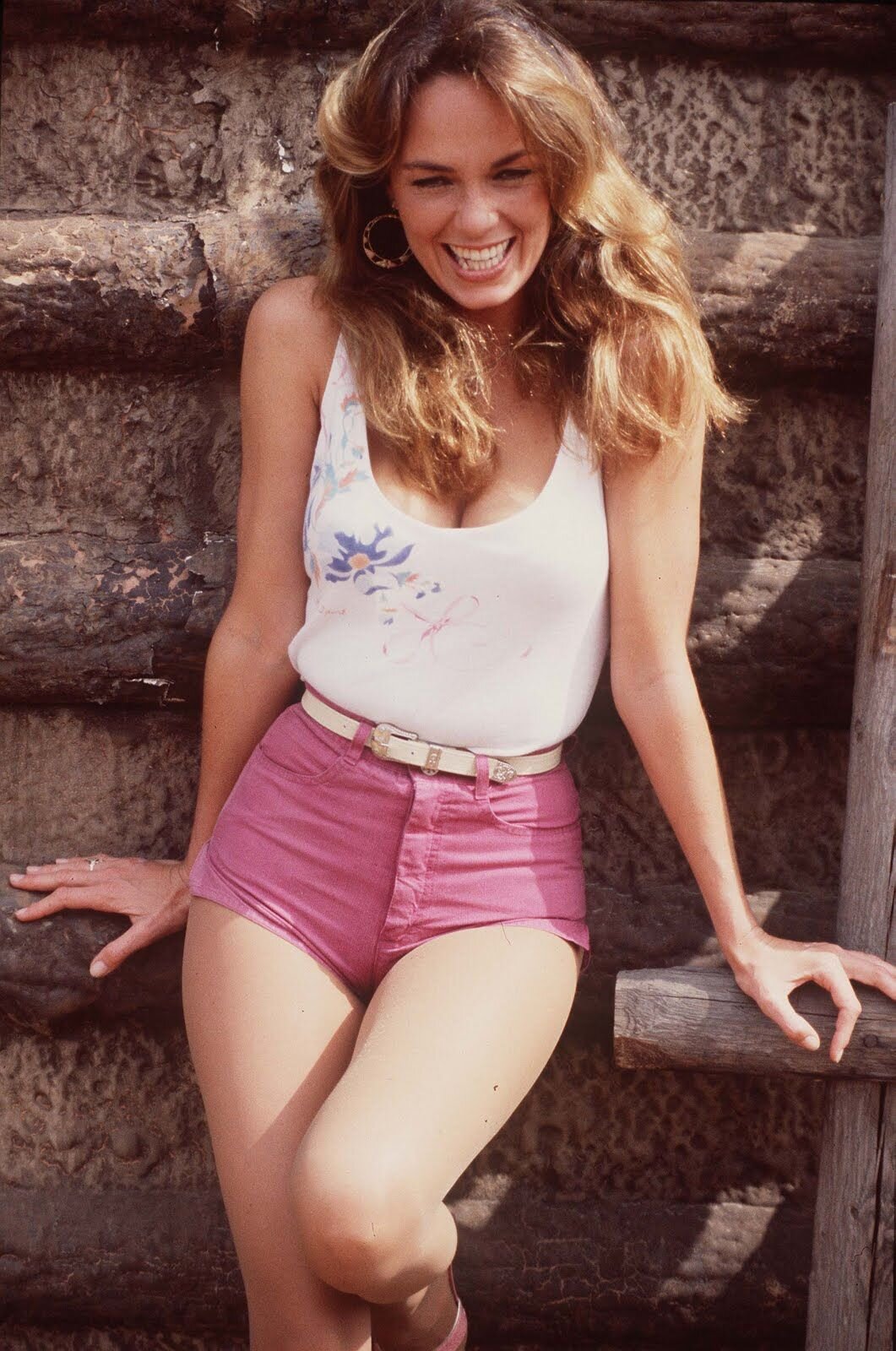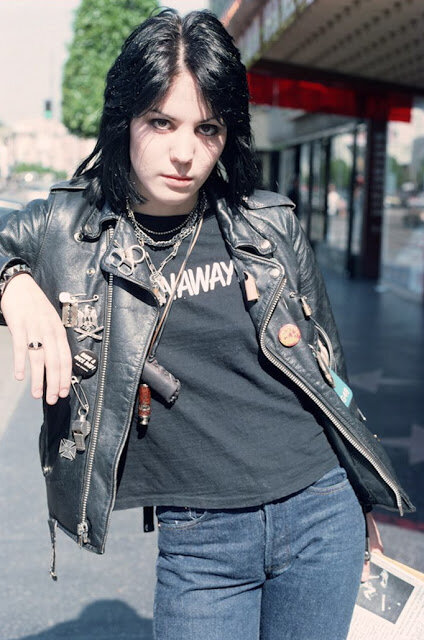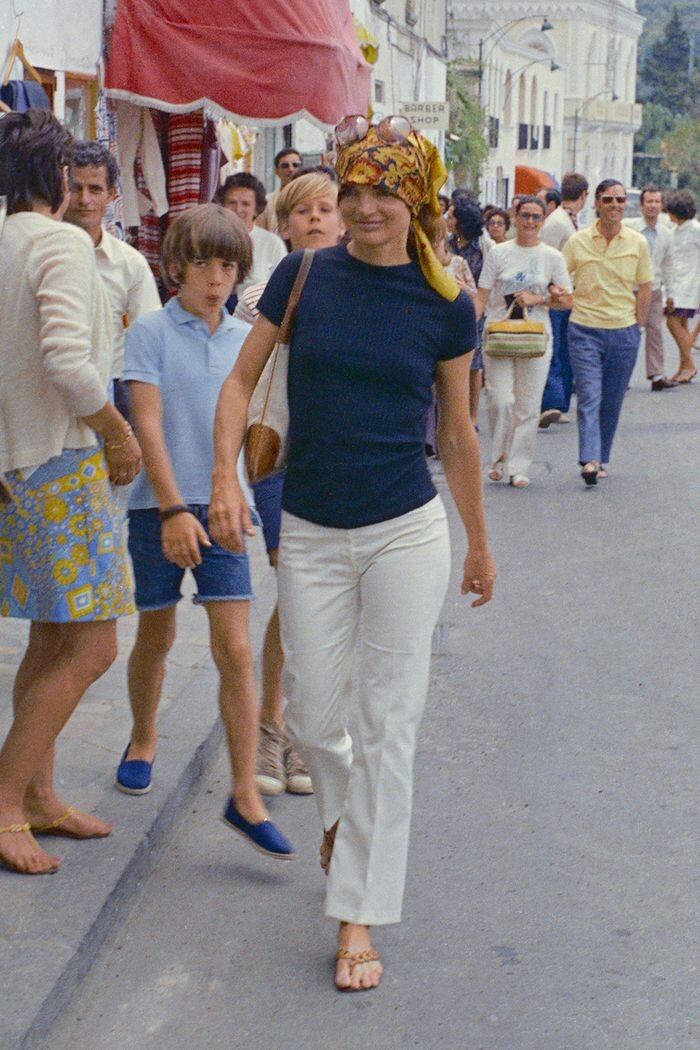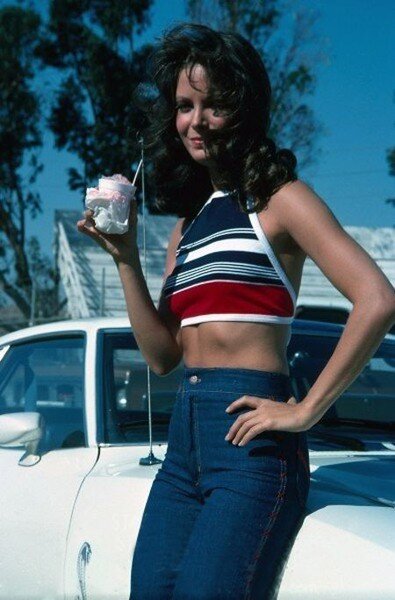The 70s Fashion Trends & Style Icons That Defined the Decade
The 1970s was a decade unlike any other. From tie-dye-wearing hippies to leather-clad punks to sequin-clad disco dancers, the 70s brought far-flung fashion together as no other decade could. During an era filled with social movements, political turmoil, and technological innovation, fashion, music, and cinema offered a much-needed escape from the chaos of everyday life.
To help you better understand the disco era— and its iconic vintage styles that keep circling back time and time again— we've broken down the fashion trends of the 1970s, as seen on the decade's biggest style icons.
From disco to boho to punk, we’ve rounded up the iconic 70s fashion trends every stylish woman should know.
Bell-Bottoms
Farrah Fawcett
Similar to today's flare jeans, bell-bottoms were fitted through the thigh and flared from the knee down. The iconic 70s fashion trend gained popularity thanks to The Sonny & Cher Comedy Hour, where they were frequently worn by husband-and-wife singing duo Sonny and Cher.
Bell-bottoms were a popular pant style for 70s disco-goers. Made from sequins, brightly-colored satin, or printed polyester, their flowy silhouette and high-rise were ideal for dancing the night away. Casual bell-bottoms, like those worn by a skateboarding Farrah Fawcett, were typically made from stretch denim or brightly-colored polyester.
Tie-Dye
Janis Joplin at Woodstock
Colorful tie-dye prints gained popularity during the hippie movement of the late 60s before exploding onto the mainstream in the 70s. While designers like Halston and Christian Dior showed high-end versions on the runway, many 70s tie-dye tees were handmade at home.
During the 60s and 70s, Janis Joplin, pictured here wearing a tie-dye dress at Woodstock, epitomized the bohemian style of the times. Her carefree, colorful layers were always accessorized liberally with layered beaded necklaces, flower crowns, and oversized sunglasses.
Clogs
Stevie Nicks
Fleetwood Mac singer Stevie Nicks was another 70s style icon with impeccable bohemian style. Her witchy velvet dresses, handkerchief hem floral frocks, and airy fringe shawls mirrored her mystical presence on stage. Despite her love of quirky accessories (peep the top hat above) and mixed prints, Stevie's looks always felt effortless and chic.
Like many boho fashion icons of the decade, Nicks often finished her looks with a pair of chunky platform clogs. The wood-soled style existed in Europe and Asia for centuries before bursting onto the scene in America. During the 70s, clogs typically featured leather uppers, chunky wooden platform soles and heels, and visible metal nailhead trims.
Wrap Dresses
Diane Von Furstenberg in her studio
Diane Von Furstenburg's form-fitting wrap dresses stood out among the oversized maxi dresses and flowing caftans that dominated the decade, making them a popular choice for fashion-savvy trendsetters. Von Furstenberg, seen above working in her showroom, first designed her iconic jersey wrap dress in 1974. Its versatility and universally-flattering silhouette have made it one of the most popular vintage dress styles of the past 50 years.
Pantsuits
Bianca Jagger
No style icon embodied the glamour and extravagance of Studio 54 quite like 70s It-Girl, Bianca Jagger. Known for her androgynous daytime outfits and lavish nightlife looks, Jagger was unafraid to take fashion risks. In 1971, just nine months after meeting at a Rolling Stones concert, she married Mick Jagger in a crisp white bespoke Yves Saint Laurent blazer and a veiled sun hat.
Though pantsuits are better known as an 80s fashion trend, they first became a fashion trend in the 60s and steadily gained popularity throughout the 70s. When Yves Saint Laurent debuted his infamous Le Smoking look—a black tailored tuxedo with a satin side stripe— in 1961, it marked the first time a French couturier presented pants as eveningwear for women. The looks caused quite a debate amongst fashion critics, as it was revolutionary at the time for women to wear blazers and pantsuits. It wasn't until 70s socialites like Nan Kempner and Bianca Jagger began sporting Yves Saint Laurent's Le Smoking jackets that the traditionally masculine look became acceptable for women.
Oversized Collars
Pam Grier
During the 70s, oversized collars were all the rage. Both men's and women's jackets and button-up shirts featured pointy oversized collars that infused the conservative styles with a bit of campy disco glamour. Wide-collars were particularly popular on leisure suits, button-up leather jackets, and printed polyester blouses like the one seen above on Pam Grier (aka Foxy Brown).
Aviator Glasses
Gloria Steinem
Worn by everyone from Elvis Presley to Farrah Fawcett to Mohammed Ai, it's little surprise that 70s aviators became one of the decade's most recognizable accessories. While the style was first created by Bausch & Lomb in 1936 to protect pilots' eyes during flight, it didn't gain widespread popularity until the 70s. Throughout the decade, the most popular sunglasses were Ray-Ban's classic aviators, an iconic style that's remained a wardrobe staple ever since.
One of the decade's most iconic pairs of aviator glasses was that of feminist writer and all-around badass Gloria Steinem. In addition to schooling the masses on gender equality and women's rights, she gave us all a lesson in minimalist 70s style. We're not sure which is more iconic: her chic turtleneck, bell-bottom jeans, and concha belt combos, or her oversized aviators and teased hair.
Kaftan Dresses
Elizabeth Taylor
Like many 70s fashion trends, kaftan dresses entail a bit of cultural appropriation. While women in the Middle East and Africa have worn the ankle-length style for centuries as traditional dress, it wasn't until the 60s and 70s that they become fashionable in Western culture. While some boho styles closely replicated traditional Indian and African prints and ceremonial garments, many offered looser interpretations in vibrant colors and psychedelic prints.
Classic 70s kaftan dresses featured an oversized, rectangular silhouette, plunging v-neck, and lightweight silk, velvet, brocade, or cotton fabric. Their effortless glamour made them a favorite of Elizabeth Taylor, pictured here in a dazzling metallic blue caftan, and Princess Grace of Monaco. During the 60s and 70s, they appeared on the runways of Emilio Pucci, Halston, Oscar de la Renta, Thea Porter, Zandra Rhodes, and more.
Hot Pants
Catherine Bach
Hot pants, Daisy Dukes, short shorts. Call them what you want; hot pants have fluctuated in and out of style since the 50s. First worn by pin-up girls and Hollywood actresses like Marilyn Monroe, the leg-baring style was designed to celebrate a women's natural curves. During the 70s, they were often made from denim, spandex, polyester, velvet, or satin. Though marketed towards women, fashion-forward men like Elton John, David Bowie, Liberace, and John Travolta also sported the 70s trend.
Considered too scandalous for the streets, short shorts became a sartorial symbol of women's sexual liberation. Though often worn in celebration of women's newfound freedom, conservative crowds associated the style with promiscuity and the sex work industry. During the early 70s, Southwest Airlines stewardess uniforms consisted of hot pants and go-go boots because "sex sells seats." And in the Academy-Award winning 1976 film Taxi Driver, Jodie Foster's character, a child prostitute, wears hot pants paired with crop tops and platform heels while on the job.
Gunne Sax Dresses
Hillary Clinton in a Gunne Sax wedding dress
70s boho style wouldn't have been the same without Gunne Sax's iconic prairie dresses. Inspired by demure Victorian femininity, the brand's boho "Granny dresses" typically had an Empire waist, maxi skirt, high lace collar, long sleeves, and decorative lace and ribbon trim. Gunne Sax wedding dresses were equally as popular as their casual everyday frocks. They were worn by many celebs and famous musicians throughout the decade, including Hillary Rodham Clinton's wedding dress in 1975.
In a 1971 advertisement, the brand described their unique aesthetic as"...bringing back memories of yesteryear, in a dress of total charm and innocence." Recently, 70s Gunne Sax dresses have seen a resurgence in popularity thanks to TikTok's growing cottagecore fashion movement.
Floppy Hats
Brigitte Bardot
During the late 60s and early 70s, floppy hats became hippie culture's most popular accessory. Wide-brimmed felt and straw hats were often worn with flowing kaftans, floral dresses, and crochet tops. Paired with oversized sunglasses, they offered ample sun protection and gave wearers a demure, playfully sexy vibe.
One notable floppy hat lover was French actress and 70s fashion icon Brigitte Bardot. As an actress, Bardot became an international sex symbol thanks to her platinum blonde hair, voluptuous curves, and distinctive gapped teeth. Her teased bouffant was fondly dubbed the "Bardot bun." After stepping away from the spotlight in the mid-70s, she became one of the world's leading animal rights activists.
Leather Moto Jackets
Joan Jett
As punk music grew in popularity, so too did punk-inspired fashion trends. Thanks to rockstars like Debbie Harry, Joan Jett, and Johnny Rotten, British designer Vivienne Westwood, and the infamous The Rocky Horror Show musical, punk slowly but surely made its way to the mainstream. Inspired by the British punk scene, leather jackets, studded belts, and creepers became sartorial symbols of 70s counter-culture.
Punk style was all about personal expression. DIY-ing your clothes showed you weren't interested in following mainstream trends or falling prey to consumer culture. Punks often covered their leather jackets with buttons, pins, paint, and patches that reflected their anti-establishment views. During the 70s, classic black leather motorcycle jackets were typically styled with fitted graphic tees, bell-bottom jeans, and studded leather belts.
Tie-Front Crop Tops
Cher on The Sonny & Cher Comedy Hour
Known as "the Goddess of Pop," Cher's enviable body and adventurous style made her one of the biggest fashion icons of the 70s. She emerged as a trendsetter during The Sonny & Cher Comedy Hour's three-year run on CBS, where some 30 million weekly viewers caught a glimpse of her eye-catching outfits (like the heart-print crop top and sequin pants above).
Throughout her six-decade career, Cher was a frequent muse to fashion designer Bob Mackey. Many of Cher's iconic sequined and feathered looks were created in collaboration with the nine-time Emmy Award-winning, three-time Oscar-nominated designer. Her ab-flashing, over-the-top outfits often channeled her Native American heritage and showgirl aesthetic.
Over-the-Knee Boots
Debbie Harry aka Blondie
Unlike 60s stretch vinyl space boots, 70s over-the-knee boots were a bit more understated. Typically made from neutral-colored suede or leather, the shoes had a bohemian feel that paired well with fluttering floral midi dresses and crocheted coordinating sets. They often had a square toe, block heel, and platform sole.
Debbie Harry, seen here wearing a black cutout mini dress and thigh-high boots during a visit to Tokyo in 1978, was one of the decade's biggest female rockstars. As a go-go dancer, Playboy Bunny, and frontwoman of the punk band Blondie, she became a pioneer of the growing punk fashion movement. Harry had an uncanny ability to make grungy, androgynous clothing incredibly cool. She often wore distressed graphic tees, hot pants, mini dresses, and over-the-knee boots and her signature beauty look consisted of teased bleach-blonde hair, bold red lips, and smudged eyeliner. Her grungy, rock-and-roll style has inspired countless musicians, including icons like Courtney Love and Miley Cyrus.
Shearling Coats
Celia Hammond
Thanks to their buttery exterior and fleecy lining, shearling jackets were the decade's must-have outerwear style of the decade. Two styles in particular could be found in almost any department store: an oversized fur coat (like 70s supermodel Celia Hammond's sheepskin number above) and a suede coat with an oversized shearling collar and cuffs. Pre-dating the realistic faux-fur and polyurethane fabrics we know today, the luxurious suede, leather, and fur coats of the 70s were made using real animal hides.
The quintessential 70s shearling coat can be seen on Kate Hudson's character Penny Lane in the 2000 film Almost Famous. Paired with a cropped crochet tank, velvet bell bottoms, and platform clogs, it accurately reflects the style of 70s rockstar groupies. Its oversized shag collar and caramel brown brocade fabric have made it one of the most famous coats in cinema history.
Crochet Tops
Cher
After a decade of unrest during the 60s, people were ready to slow down, reconnect with nature, and try their hand at old-school hobbies like knitting and crocheting. Throughout the 70s era, crafty fashionistas whipped up everything from bikinis to ski hats. One stitch in particular, the granny square, was particularly popular for sweaters, jumpsuits, bell bottoms, and ponchos.
Head Scarves
Jackie Kennedy
No accessory embodies the carefree attitude of the times quite like the humble scarf. Taking inspiration from 60s hippies, small square scarves were typically styled as headbands, turbans, headscarves, and neckties. Often made from brightly-printed silk or polyester, they paired perfectly with maximalist maxi dresses and statement makeup.
If you're looking for inspiration for how to wear a headscarf, look no further than Jackie Kennedy, seen here on vacation in Capri. Her oversized sunglasses, headscarves, and sleek separates have become the gold standard of minimalist accessorizing. During the 60s, she frequently topped her monochrome Chanel tweed suits with pillbox hats, pearls, and satin gloves. After her husband's death, Jackie O's style shifted from bright colors and boxy shift dresses to sleek tailoring, printed maxi dresses, and chic fitted basics.
Halter Tops & Dresses
Jaclyn Smith
Made famous by 70s fashion designers like Halston and Missoni, halter tops were among the most popular women's tops in the 70s. Unlike traditional shoulder straps, the straps on halter tops and halter-neck dresses are tied behind the neck, leaving the shoulders and upper back exposed. Knit halter crop tops, like the striped number seen above on Charlie's Angels actress Jacyln Smith, were often paired with bell bottoms or hot pants and platform heels.
During the women's rights movement of the late 60s, many women ditched their bras and restrictive undergarments in favor of comfortable garments that celebrated their natural shape. This made braless styles like halter tops particularly appealing to young women, especially those who identified as hippies or feminists.
Satin Slip Dresses
Diana Ross
The energetic feel of 70s disco music was embodied by the extravagant styles worn by Studio 54 attendees. Under the flashing lights and spinning disco ball, high-shine fabrics and unique textiles caught the light and created movement as the wearer danced and helped them stand out amongst the crowd. Popular disco clothing styles include shiny satin slips, spandex leotards and bodysuits, sequin dresses and jumpsuits, hot pants, and fur coats.
Diana Ross' glamorous silk maxi dresses, lavish jewelry, and oversized fur coats were the epitome of 70s disco chic. After splitting with The Supremes in 1970 to pursue a solo career, she released chart-topping songs like Ain't No Mountain High Enough, Reach Out and Touch (Somebody's Hand), and I'm Coming Out. Throughout her career, Ross often collaborated with Bob Mackie to create the ethereal metallic gowns, batwing dresses, and sequined jumpsuits.
Tube Tops
Suzanne Somers on The Love Boat
Legend has it that tube tops were created in 1971 by pure mistake, but thanks to New York designer Elie Tahari, they became one of the most popular clothing items of the 70s. "I am not wearing a bra! I am a modern hippie girl!” said Tahari, recalling his clients' excitement when the trendy top first emerged on the fashion scene.
Popular amongst braless hippies and Studio 54 attendees alike, tube tops became synonymous with the era's carefree attitude. One adamant tube top wearer was American actress Suzanne Somers, seen above wearing a classic 70s tube top during an episode of The Love Boat. Somers is best known for her role as Chrissy Snow on the American sitcom Three's Company.
